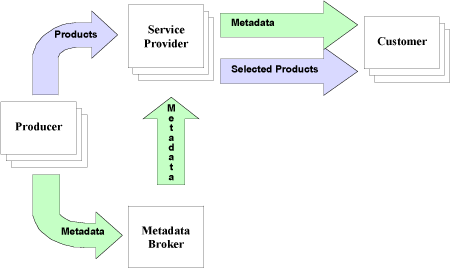IWICOS Broker: Meteorology, Sea-Ice and Ocean Data Interoperability
in the Northern Seas
by Robin Berglund and Jyrki Haajanen
As a result of the potential exploitation of natural resources, requiring safer navigation along the shipping routes of the Northern Seas, the importance of the interoperability of data provided by the national meteorological and research institutes is rising significantly. Furthermore, the need for efficient monitoring of ongoing climate change creates new requirements for the accessibility of this kind of data by researchers.
VTT is currently taking part in the European Commission-funded IWICOS project, part of the IST Programme. The goals of the project are to research, evaluate and demonstrate the technologies and approaches required for an interoperable weather, ice, and ocean data service. The aim of the demonstration is to plan and implement a service chain for interoperable cross-organisation GIS data production and delivery for seafarers, and to illustrate the use of such data.
IWICOS Architecture
The system architecture consists of four different subsystems: the Producer Server, the Broker, the Facade, and the Client Software. Together, the Facade and the Client Software form the End-User System. Data providers implement the Producer Server and integrate it into their existing production process. Correspondingly, each Service Provider implements an End-User System. The subsystems form an interoperable service chain for producers and users of met, ice, and ocean data (see Figure).

The IWICOS service chain.
The IWICOS service chain starts from the Producer Server creating the GIS data products and XML-based metadata descriptions of their contents. The next element in the service chain is the Broker. The Producer Servers inform the Broker when they have new data available. The Broker then collects their metadata for a single central storage. The Facade forms the next stage of the service chain - it functions as a ground station for a ship out at sea. The Facade has a high-bandwidth Internet connection and can perform the necessary filtering and selection of data prior to sending it over to the Client Software on the ship. Using the End-User system, the customers can query the metadata to find suitable products.
The Metadata and Data Formats
The metadata in the IWICOS project was specifically defined for the purposes of the project – existing metadata standards for GIS services were found to be too large to implement within the scope of a research project. The metadata definition is given as an XML Schema and the metadata files are XML documents instantiated from this schema.
In order to reduce the complexity of the implementation, the set of data formats for the communication between the Producer Servers and the Facades is limited to Binary Sequential Files (BSQ), GRIB (GRIdded Binary), Shapefile, and XML. Within the End-User Systems (Facade and Client Software pair) there are no such limitations. The Facades can use the base types listed above to generate products in any format. Basically, the End-User System is a black box – the subsystems outside should not (and will not) need to be interested in what happens therein.
IWICOS Broker
The Broker communication is implemented using Remote Procedure Calls (RPC) implemented over the Simple Object Access Protocol (SOAP). The marshalling of arguments in the Broker is based on an automatic Java to XML-type conversion provided by the SOAP framework.
The aim, when choosing the Broker software platform components, was to mini-mise the cost. Freely available components were available for each major task: operating system, web server, servlet engine, database, and communication.
The Broker has two external interfaces, one for the Producer Servers to manage the Broker’s metadata content, and one for the End-User Systems to pose queries on the Broker’s metadata content. Altogether these interfaces hold four separate operations. The access is based on common low-level web service technologies SOAP and XML.
The basic elements of the web services and Semantic Web technologies XML and SOAP protocol can be used efficiently to implement an interoperable service chain. In the near future, more feasible development of business-to-business solutions and networked service and supply chain implementations will be available as the higher layers of this technology family are brought into use.
Links:
http://iwicos.vtt.fi
http://www.vtt.fi/tte/pub/tte1/iwicos/
http://www.nrsc.no/~iwicos/
Please contact:
Robin Berglund, VTT Information Technology
Tel: +358 9 456 6018
E-mail: robin.berglund@vtt.fi
|
